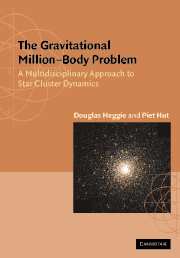Book contents
- Frontmatter
- Contents
- Preface
- PART I INTRODUCTIONS
- PART II THE CONTINUUM LIMIT: N → ∞
- PART III MEAN FIELD DYNAMICS: N = 106
- PART IV MICROPHYSICS: N = 2
- PART V GRAVOTHERMODYNAMICS: N = 106
- PART VI GRAVITATIONAL SCATTERING: N = 3
- 19 Thought Experiments
- 20 Mathematical Three-Body Scattering
- 21 Analytical Approximations
- 22 Laboratory Experiments
- 23 Gravitational Burning and Transmutation
- PART VII PRIMORDIAL BINARIES: N = 4
- PART VIII POST-COLLAPSE EVOLUTION: N = 106
- PART IX STAR CLUSTER ECOLOGY
- Appendix A A Simple N-Body Integrator
- Appendix B Hints to Solution of Problems
- References
- Index
22 - Laboratory Experiments
Published online by Cambridge University Press: 05 June 2012
- Frontmatter
- Contents
- Preface
- PART I INTRODUCTIONS
- PART II THE CONTINUUM LIMIT: N → ∞
- PART III MEAN FIELD DYNAMICS: N = 106
- PART IV MICROPHYSICS: N = 2
- PART V GRAVOTHERMODYNAMICS: N = 106
- PART VI GRAVITATIONAL SCATTERING: N = 3
- 19 Thought Experiments
- 20 Mathematical Three-Body Scattering
- 21 Analytical Approximations
- 22 Laboratory Experiments
- 23 Gravitational Burning and Transmutation
- PART VII PRIMORDIAL BINARIES: N = 4
- PART VIII POST-COLLAPSE EVOLUTION: N = 106
- PART IX STAR CLUSTER ECOLOGY
- Appendix A A Simple N-Body Integrator
- Appendix B Hints to Solution of Problems
- References
- Index
Summary
The analytical approaches sampled in the previous chapter have some good uses, but providing accurate useful numbers is not always one of them. They may provide suitable scaling laws, showing how the statistics of three-body scattering depends on the masses involved, but there is usually an overall coefficient that must be determined in some other way. We now turn to a technique which can fill in such gaps. Actually it is marvellous how complementary the two techniques are. Numerical methods are not good at determining cross sections of very rare events, e.g. very close triple approaches, but it is often precisely these little corners of parameter space where analytical methods are feasible.
Numerical methods offer astrophysicists a tool quite analogous to the kinds of particle colliders in use by high-energy physicists. There beams of particles are fired at targets (or other particles), and the relative frequencies of different kinds of collision debris can be observed. Using numerical methods we can see what happens when a binary (the target) is fired on by a single particle, and the experiment may be repeated as often as we care.
Numerical studies of three-body encounters go back almost one hundred years. In 1920 L. Becker published results on exchange encounters (see Chapter 19) which were carried out with the aid of ‘mechanical quadrature’. But it was not until the era of electronic computing that the investigation of triple scattering orbits became a sizable industry.
- Type
- Chapter
- Information
- The Gravitational Million–Body ProblemA Multidisciplinary Approach to Star Cluster Dynamics, pp. 212 - 220Publisher: Cambridge University PressPrint publication year: 2003



